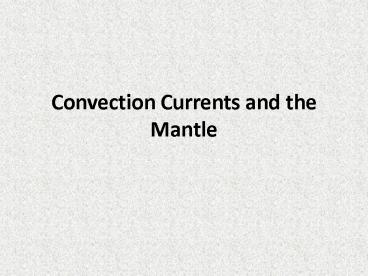Convection Currents and the Mantle - PowerPoint PPT Presentation
1 / 30
Title:
Convection Currents and the Mantle
Description:
At the top of the asthenosphere, the hot material spreads out and pushes the ... This cooler material sinks back into the asthenosphere. ... – PowerPoint PPT presentation
Number of Views:2590
Avg rating:3.0/5.0
Title: Convection Currents and the Mantle
1
Convection Currents and the Mantle
2
Objectives
- explain how heat is transferred
- identify what causes convection currents.
3
Heat Transfer
- The movement of energy from a warmer object to a
cooler object is called heat transfer.
4
- Heat is always transferred from a warmer
substance to a cooler substance.
5
- There are three types of heat transfer
- radiation, conduction, and convection.
6
radiation
- The transfer of energy through empty space is
called radiation.
7
- Heat transfer by radiation takes place with no
direct contact between a heat source and an
object.
8
- For example, radiation enables sunlight to warm
Earths surface.
9
conduction
- Heat transfer by direct contact of particles of
matter is called conduction.
10
- In conduction, the heated particles of a
substance transfer heat to other particles
through direct contact.
11
- An example is when a spoon heats up in a hot pot
of soup.
12
convection
- The transfer of heat by the movement of a heated
fluid is called convection. - Fluids include liquids and gases.
13
- During convection, heated particles of a fluid
begin to flow, transferring heat energy from one
part of the fluid to another.
14
- Heat transfer by convection is caused by
differences in temperature and density within a
fluid.
15
- Density is a measure of how much mass there is in
a volume of a substance.
16
When a liquid or gas is heated, the particles
move faster. As they move faster, they spread
apart.
- Solids molecular vibration
cooler -
- Liquids molecular motion
-
temperature -
v -
v - Gasses rapid motion
v -
warmer
17
- Because the particles of the heated fluid are
farther apart, they occupy more space. - The fluids density decreases.
18
- But when a fluid cools, the particles move closer
together and density increases.
19
- An example of convection occurs in heating a pot
of soup on a stove. - As soup at the bottom of the pot gets hot, it
expands and becomes less dense.
20
- The warm, less dense soup moves upward, floating
over cooler, denser soup. - At the surface, the warm soup spreads out and
cools, becoming denser.
21
- Then gravity pulls this cooler, denser soup down
to the bottom, where it is heated again and
begins to rise.
22
convection current
- This flow that transfers heat within a fluid is
called a convection current.
23
- The heating and cooling of the fluid, changes in
the fluids density, and the force of gravity
combine to set convection currents in motion.
24
- Convection currents continue as long as heat is
added to the fluid.
25
- Convection currents flow in the asthenosphere.
26
- The heat source for these currents is heat from
Earths core and from the mantle itself.
27
- Hot columns of mantle material rise slowly.
28
- At the top of the asthenosphere, the hot material
spreads out and pushes the cooler material out of
the way.
29
- This cooler material sinks back into the
asthenosphere. - Convection currents like these have been moving
inside Earth for more than four billion years!
30
END































